
|

|
Honor, Dueling, and Drengskapr in the Viking Age
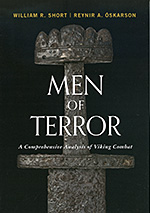 |
Much of the text presented on this page is out-of-date. Until we find time to make the needed updates to this page, we strongly encourage readers to look at this topic as it is presented in our new book, Men of Terror, available now from your favorite book seller. |
|
This Norse concept of "honor" and of a "good name" and the extraordinary lengths to which a Norseman went in order to protect his good name require a far lengthier explanation than I can give here. In part, that's because similar concepts don't exist in modern western culture. Thus, English language translations of the Norse words are clumsy and imprecise. For the best explanation, I suggest reading the chapter in Sigurđur Nordal's Íslenzk menning. (The full citation is in the Hurstwic References page.) However, the Íslendingasögur (Sagas of the Icelanders) provide a marvelous (if somewhat distorted) window on the ethics and morality of Icelandic society in the Norse era. Because the sagas were not written down until hundreds of years after the events they describe, they represent a confluence of ideas about ethics and morals from both the pagan saga age (when the stories are set) and the Christian Sturlunga age (when the stories were written). |
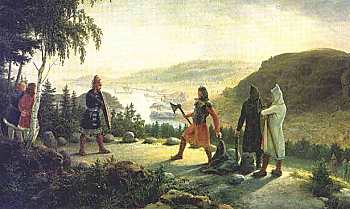 |
The range of behaviors in Norse society ran the gamut from drengskapr to níđr. The first is usually translated as "honor" and the second as "shame".
At one extreme, the state of drengskapr was admired, and the actions of a drengr would be emulated and praised.
At the other extreme, the state of níđr was despised, and the actions of a níđingr would be avoided and reviled.
Snorri Sturluson wrote, "Valiant men who exert a good influence are called drengr." A drengr possessed bravery, nobility, magnanimity, a sense of fair play, respect for others, the strength to do what is right, and a sense of personal honor. Physical bravery was taken for granted. More important was self-control. A drengr showed equanimity in the face of danger, not because of insensitivity or stupidity, but because the danger and the possible risk to life and limb was unimportant compared to the need to maintain self-respect and the respect of the community. There was a practical side to such imperturbability, because not only was it unmanly to show concern or fear in the face of danger, but also useless.
Examples from the saga illustrate that imperturbability. In chapter 6 of Gunnlaugs saga ormstungu, the earl noticed Gunnlaug's injured foot that oozed pus and blood with every step. The earl asked why he didn't limp. Gunnlaugur replied, "One mustn't limp while both legs are the same length." In a battle described in chapter 30 of Heiđarvíga saga, Ţorbjörn's foot had been cut off at the ankle, but he continued to fight. His opponent Barđi called him a troll for continuing to fight without a foot. Ţorbjörn said, "You don't have to be a troll to bear a wound well and fight as long as you can. That should be regarded as drengskapr."
A níđingr was the object of hate and scorn. He was an outcast. Typical causes for such disgrace included: cowardice; treachery; shameful acts (such as killing kinsmen or defenseless people); breaking one's oath. When a man betrayed the trust of another man, that man would become known as a níđingr. In chapter 32 of Gísla saga, Eyjólfr ordered his men to kill a woman, a despicable act. Hávarđr stood up to him, telling the men not to do níđingsverk (the work of a níđingr).
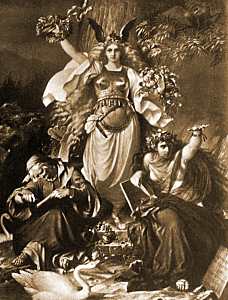 |
Two other beliefs influenced the behavior of Viking-age people: fate and luck. The Norse myths say that when a baby is born, the three Nornar (women of destiny, left) choose the moment of its death. The Norse people believed that while nothing else in life was predetermined, no man could live past the moment chosen for him by the Nornar. Nothing could change that time, regardless of whether a person stayed at home in bed, or went out on bold adventures. Since there was nothing to lose and everything to gain by being venturesome, Norse people tended to be bold and daring, seeking out ways to increase honor and enhance their good names. There are countless examples of this outlook on life in the sagas. Perhaps the most succinct comes from chapter 8 of Kjalnesinga saga. Kolfinnur announced his plan to duel with Búi. When people suggested that the match was unevenly stacked against him, Kolfinnur replied, "There are two outcomes to every danger: either I will live or I will die." That is not to say that people were foolhardy. In chapter 7 of Vatnsdćla saga, Ingjaldur advised young Ingimundur and Grímur, as they left on their first Viking raids: "Beware of going where overwhelming force opposes you. There is more honor in accumulating little by little than in overreaching and falling down flat." Ingimundr and Grímur took the advice to heart. They did not attack where it made no sense, and by the end of their first raiding season, they had accumulated five ships. |
Additionally, the Norse people strongly believed in the power of luck (gćfa). Nothing could stop a lucky man, and little could help an unlucky man. Men sought to ally themselves with lucky men and to possess lucky things. Ásgautur was challenged to a duel by a berserk over his sister's hand in marriage, as told in chapter 4 of of Víga-Glúms saga. Ásgautur went to the brothers Ívarr and Hreiđarr and asked for their support, saying "I'm not strong enough for a duel unless I get the benefit of your good luck as well."
Likewise, men distanced themselves from unlucky men and disposed of unlucky things. Not only was it considered dishonorable to take the weapons from dead men after a battle, it was probably considered unlucky as well. Since those weapons didn't bring much luck to their former owners, it's not reasonable to expect any different luck for subsequent owners.
People looked to omens and dreams for guidance on events yet to come. Chapter 2 of Grćnlendinga saga says that when Leifur Eiríksson planned his first voyage of exploration to Vínland, he insisted that his father, Eiríkur, lead the expedition, because he had the greatest luck of any of his kinsmen. But as Eiríkur rode to the ship, his horse stumbled, and he fell off. He said it was not intended that he live in any other land but the one he was in now, and so he returned home.
Dishonor could be communicated through a variety of means. One powerful means was through words. Certain insults were thought to be so powerful that Grágás, the medieval Icelandic law book, said that a man was free to kill someone who spoke certain forms of insults. Most of these insults have as their basis the implication that a man acted in a womanly manner. To a Norseman, cowardice and effeminacy were two sides of the same coin. Effeminacy implied sexual and social impotence. To suggest that a Norseman was no man (such as suggesting that he was the submissive partner in an encounter) was a mortal insult. Grágás (St376) says that if a man calls another man womanish, or says that he has been buggered, the recipient of the insult has the right to kill in retaliation.
In chapter 123 of Njáls saga, Flosi, thinking he had been insulted by Njáll, taunted him by saying, "There are many who can't tell by looking at him whether he is a man or a woman." Njal's son, Skarpheđinn, returned the taunt, with interest, saying, "You are the sweetheart of the troll at Svinafell, as is said, he uses you as a woman every ninth night." Flosi later made good on the insult by burning down Njál's house, killing both Njáll and Skarpheđinn (along with many others) in the flames.
In addition to being used to dishonor, insults were used to egg people on to action. Women often used taunts to incite the men in their family to action when the men might otherwise be content to sit and do nothing. Kolfinn's mother, Ţorgerđr, grew weary of his sitting and lounging by the fire all day, as is told in chapter 7 of Kjalnesinga saga. She urged him to go to the farm at Kollafjörđur, when men were playing games and other manly deeds, and where two suitors were vying for the hand of Olöf. "You're so worthless that you just sit by the firepit, a distress to your mother. It would be better for you to be dead than to have this disgrace." Kolfinnur got up, went to the farm and eventually killed one of the suitors and fought a duel with the other over Olöf.
Taunts and insults were also used during fights to anger an opponent into making a mistake. As Ţórđur and Eyvindur fought against Össur and eleven of his men in chapter 9 of Ţórđar saga hređu, Ţórđur called out that it didn't seem to be going well for Össur. "You should be a leader of your men, instead of just using them as your shield." In his anger, Össur lunged at Ţórđur. Ţórđur blocked with his shield and made a cut that separated Össur's ribs from his spine, killing him.
The sagas are filled with examples of insults that cut to the quick, but which are filled with humor to anyone not on the receiving end of the insult. In chapter 18 of Víga-Glums saga, Bárđur decided against fighting his horse against one belonging to Vigfús. Vigfús taunted him, saying Bárđ's horse was no match for his own, and Vigfús received a vicious taunt from Bárđur in return: "You must have stood by the pantry shelves discussing cooking with your mother more often than you've been to horsefights, or that's how it seems from your little blonde beard."
In chapter 3 of Ţórđar saga hređu, Ásbjörn came to Iceland and found himself attracted to Sigríđur. Her brothers cared little for this, and they gave Ásbjörn the nickname veisugalti (cesspool-hog). Later, at a ballgame, Ásbjörn was matched against one of the brothers, Ţórđur. During the game, Ţórđur threw down Ásbjörn and said, "Cesspool-Hog has fallen." Later, Ásbjörn threw down Ţórđur and said, "You're not ready to play with grown-ups yet, are you, Downy-Cheeks?" using a nickname that implied Ţórđur had no beard and his cheeks were as smooth as a maiden's.
Insults were thought to be even more powerful when expressed in poetry. The penalty for composing even half a stanza of poetry with defamation or mockery in it was full outlawry (Grágás K238). The penalty for reciting such poetry was the same as for composing it. Throughout Bjarnar saga Hítdćlakappa, Björn traded scurrilous verses with Ţórđur, who had crafted the lie that Björn was dead in order to marry Björn's intended bride, Oddný. After a number of ambushes and deaths, a settlement meeting was called, as described in chapter 29. Once the settlement had been arranged, Ţórđur realized Björn had recited one more verse than he had. Ţórđur recited an additional insulting verse, evening the score, which resulted in the settlement being abandoned.
Dishonor could also be shown with actions. A variety of activities meant to disgrace or mock a man are described in the stories and prohibited by law (e.g., Grágás St361). Activities such as intentionally making someone dirty, tearing or cutting their clothing, or anything meant to cause disgrace could be punished with full outlawry.
A memorable example from the stories is described in chapter 25 of Reykdćla saga og Víga-Skútu. Ţorgeirr wanted to avenge the death of his father on Skúta at the Alţing meeting. At these meetings, people lived in temporary buildings called búđir (booths). To get Skúta's attention, Ţorgeirr arranged for Skúta's booth to be used as a latrine all summer before the meeting. Skúta repaid the favor by killing Ţorgeirr with the blow from his axe.
Dishonor could be shown by offering inappropriate gifts or compensation. Refur went to ask Ţorbjörn for compensation for the killing of a farmhand, as told in chapter 3 of Króka-Refs saga. Ţorbjörn offered Refur a untempered knife, and spoke a sentence that is cleverly alliterative in Icelandic: "A soft person (i.e., a coward) should be offered a soft thing (i.e., an untempered blade)." Refur turned down the offer by thrusting his spear through Ţorbjörn.
A gift that suggested that a man was womanish was a mortal insult. Again, chapter 123 of Njáls saga provides an example. A settlement was arranged between Flosi and Njáll, in which Njáll was to pay a large sum of money to Flosi. Njáll and his sons and his supporters and the arbitrators themselves all contributed. On top of the enormous pile of silver, Njáll laid a silk cloak as a gift to Flosi. When Flosi was brought to the Law Council to see the settlement, he asked whose garment it was. Although not explicitly stated, Flosi may have interpreted the fancy garment as a woman's cloak, added to the settlement as an insult to him.
Some forms of insult in the Viking age would be instantly recognizable in the modern era. In chapter 39 of Grettis saga, a boy straightened a finger to Grettir. In a rage, Grettir hit the boy to the floor, knocking him out.
Physical symbols of a man's shame might be erected as a means to signal dishonor. In chapter 2 of Gísla saga Súrssonar, it appeared that neither Gísli nor Kolbjörn arrived to fight a duel with Skeggi, a shameful failure. Skeggi told a carpenter to make wooden effigies in the likeness of Gísli and Kolbjörn, one behind the other, to forever mock and shame them. Although not explicit, it's clear that a sexual insult is intended.
|
The ultimate symbol of shame was the níđstöng (scorn-pole). Chapter 57 of Egils saga Skalla-Grímssonar describes the níđstöng raised by Egill against King Eiríkur and Queen Gunnhildur after receiving shameful treatment from them while trying to recover his wife's inheritance. Egill placed a horse's head on a hazel pole driven into the rocks near shore. He invoked a curse against the king and queen, demanding no rest for landvćttir (land spirits) until they had driven the king and queen from the land. Turning the horse's head towards the mainland where the king and queen were located, Egill carved the curse in runes on the pole. A 20th century sculpture by Gustav Vigeland that depicts this episode is shown to the right. Chapter 34 of Vatnsdćla saga describes the scorn-pole erected by Jökull towards Bergur and Finnbogi after they failed to show up at the appointed time and place for a duel. Jökull raised the scorn-pole, carved a man's head at the end of the pole and a curse in runes along the pole. He killed one of Finnbogi's mares, cutting it open at the breast and setting it on the pole, facing towards Finnbogi's farm. |
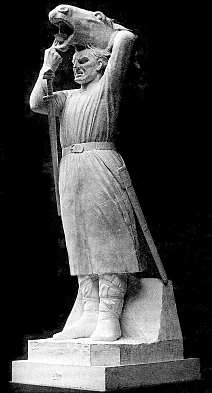 |
A man's fame and honor in life, and his good name after death, were so important that a man was hypersensitive to the opinion of the community. He might not otherwise fear anything nor flinch at death, but the respect of the community was of paramount importance. Any offence in word or deed, or anything that might blot one's honor had to be dealt with firmly in order to maintain that respect. So a Norseman was constantly on the alert for wrongs against his person or his name. Those wrongs were proclaimed openly, and then avenged.
Vengeance was not a punishment for the person on whom it was inflicted. Rather, it was a reparation to the honor of the person who was being avenged. Vengeance repaired the honor of the injured person. Vengeance need not even be worked upon the individual who caused the offense. Killing a close family member was nearly as good as killing the responsible party. For instance, in Hrafnkels saga Freysgođa, Hrafnkel saw Sám's brother ride by, and he killed the innocent fellow to avenge himself on Sámur.
Since the power of the state was weak, vengeance was sanctioned and even encouraged by the laws. The medieval Icelandic lawbook Grágás (K 86) permitted a man who was seriously injured to avenge himself without penalty at any time up until the time the case was brought to court. And even when the law forbade vengeance, there were cases when public opinion demanded it.
Duels were an accepted way of making good on verbal injuries. The less formal form of dueling was known as einvígi (single combat), while the more formal duel was called a hólmganga (going to the island) because duels were frequently fought on small, deserted islands. The islands prevented cowards from running away, and limited possible interference from third parties.
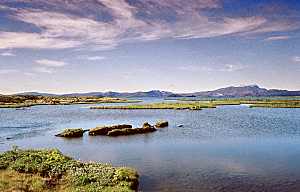 |
The island on which duels were fought at Ţingvellir (the site of Iceland's national parliament) no longer exists, due to the geological changes in the landscape. The duel site is generally considered to have been on an island in the Öxará (right) near where the river enters the plain. Some of the sagas attest to this location, including chapter 16 of Ljósvetninga saga. However, it has also been suggested that the island was in the area now occupied by Ţingvallavatn, the lake adjacent to the site (left). |
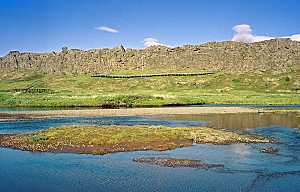 |
Duels were conducted according to formal rules. According to the 13th century Swedish text Hednalagen, the injured party said, "You are not a man's equal and not a man at heart." The second party responded, "I am as much a man as you."
|
The time and place for the duel was set. If either party failed to show for any reason, he was branded a níđingr. Chapter 33 of Vatnsdćla saga describes an example. Bergur and Finnbogi challenged Jökull and Ţorsteinn to a duel to take place at the haystack wall on the island in the river below Borg, Finnbogi's farm. (The farm, as it appears today, is shown to the right.) |
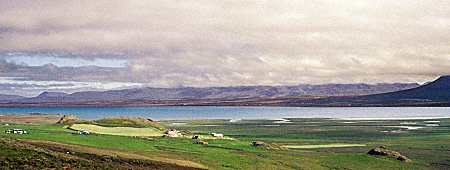 |
Jökull responded, "You must now turn up to the duel if you have a man's heart, rather than a mare's. And if anyone fails to turn up, then a scorn-pole will be raised against him with this curse - that he will be a coward in the eyes of all men, and will never again share the fellowship of good folk, and will endure the wrath of the gods, and bear the name of truce-breaker." Bergur and Finnbogi failed to show up for the duel, and Jökull and Ţorsteinn erected a scorn-pole on the site to dishonor them, as described earlier in this article.
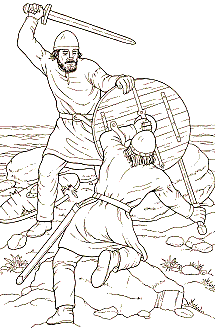 |
Many of the descriptions of duels in the sagas begin with a recitation of the dueling law (hólmgöngulög). The law seems to vary from one saga to the next, but there are similarities. For the duel, a cloak was laid on the ground, about 2.5m square (8 feet square, which is considerably larger than a typical man's cloak). If either man stepped off the cloak, he lost the duel and was deemed to be níđingr. Weapons used were swords, spears, and axes. Each man was allowed three shields, in the likely possibility of breakage. If either man's blood fell on the cloak, he was permitted to withdraw from the duel. The man with the worse wound could buy himself off. However, if a man died, all his property went to the winner, so most fights were to the death. Chapter 9 of Svarfdćla saga provides slightly different details:
|
Chapter 11 of Gunnlaugs saga ormstungu says that the party who was challenged was to strike the first blow. It also states that when a man became weaponless, he was defeated.
There is the curious practice of bearing the shields for the participants in a duel. An example occurs in chapter 9 of Svarfdćla saga. The earl offered to bear Ţorstein's shield for him, but Ţorsteinn declined, saying that no one need be put at risk for his sake: "I will bear my shield myself."
Chapter 4 of Víga-Glúms saga tells that a berserk had challenged Ţorsteinn to a duel. Eyjólfur was asked to hold Ţorstein's shield, but declined, saying there was little credit in it. Instead, he offered to take Ţorstein's place in the duel. Ívar offered to hold Eyjólf's shield, but Eyjólfur preferred to hold his own, quoting the old saying "self's hand is best."
The shield bearer clearly was an active participant in the duel. Kormákur held Steinar's shield in a duel with Bersi, as described in chapter 12 of Kormáks saga. When Bersi's sword stuck in Steinar's shield, Kormákur lifted the shield, allowing Steinar to make an attack that caused a serious wound to Bersi, causing him to fall.
The stories say that before a duel, a sacrificial bull was brought to the dueling site and was slaughtered by the winner of the duel. In chapter 65 of Egils saga, it is said that Egill killed Atli in a duel by grappling with him and biting out his throat. While still in a battle frenzy, Egill picked up the sacrificial bull and threw it down onto the ground, breaking its back.
Chapter 10 of Kormáks saga has perhaps the most detailed, if slightly fantastic, description of the dueling laws and customs. On one hand, the saga text confirms some of the details from other sources that have been outlined above. Yet on the other hand, the saga text states, for example, that the man who prepares the duel site must approach the cloak in such a way that he can see the sky between his legs, all the while grasping his earlobes and speaking the invocation of the tjösnublót.
Some duels were settled quickly, such as the duel described in chapter 4 of Víga-Glúms saga. Eyjólf's first blow cut off Ásgaut's foot, and so Ásgautur paid to release himself from the duel. He lived the rest of his life as a cripple.
Yet some duels went on for a very long time. Ţorsteins ţáttur stangarhöggs tells of a duel between Ţórsteinn and Bjarni that lasted so long that they stopped multiple times to rest and refresh themselves. The description of this duel is fascinating because the author leaves many questions unanswered. Was Bjarni really tired, or was he merely playing with Ţorsteinn and testing him? The text supports multiple interpretations.
Ljósvetninga saga (chapter 30) mentions another form of hólmganga, with four men on each side. Hrólfur said he planned to challenge Eyjólfur to a duel and to offer him either a fight with four men on each side, or just the two of them. Interestingly, as the challenger, it appears that Hrólfur had the privilege of choosing who the additional men would be on each side. Hrólfr listed the three who would fight on Eyjólf's side, and said that on his side, he would choose mercenaries and robbers.
Other forms of dueling are also mentioned in the stories. Chapter 17 of Flóamanna saga describes a tub duel (kerganga), in which two men were sealed into a tub or cask. They then fought with staffs that were one ell long (50cm, about 20in).
People trying to make sense of the duel descriptions
have come up with alternative interpretations than what I've presented here. One
has to assume that when the sagas were written, duels had long since ceased to
be a common occurrence. Chapter 11 of Gunnlaugs saga ormstungu
describes the last duel to take place in Iceland, between Gunnlaugur and Hrafn,
which took place at the Alţing early in the 11th
century. The next day, the law council abolished duels. (The duel was a draw,
and the saga says that Gunnlaugur and Hrafn agreed to continue the duel in
Norway.)
|
|
©1999-2025 William R. Short |